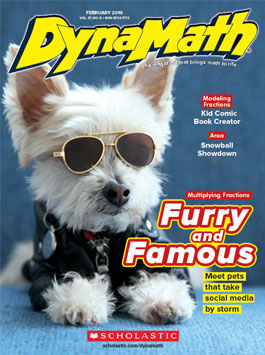Did you make it to NCTM or NCSM this year? If you did, we’d love to hear about your experiences! (E-mail us! ) If you didn’t, don’t worry—we attended in order to be your eyes and ears too. Here are some of our favorite moments from this year’s conferences:

Our 5 favorite take-aways from NCTM & NCSM
Here’s our recap of this year’s annual conferences in San Antonio
The Scholastic team meets with Arizona math specialists Kim Edelson (far left) and Melinda Villalovos (far right) during this year’s NCSM conference.
1. Make the Mathematical Practices supreme
Talk to any math education expert and one piece of advice seems practically universal —teaching the Standards for Mathematical Practice is critical to your instruction. The eight process and proficiencies structure your teaching and provide goals for student learning. (Need a refresher? Check out this blog post.)
“If every teacher was utilizing the eight mathematical practices, the content in the curriculum would take care of itself,” says Christine Moynihan, author of Common Core Sense. Moynihan presented at NCTM and NCSM, encouraging teachers to take time to go deep into each practice. This helps students engage in the productive struggle necessary for their math development.
2. Use cumulative review every day, because no one learns after one or two lessons
Looking to get fired up about teaching math? Check out one of Steve Leinwand’s presentations! The analyst at the American Institutes of Research and former math teacher brought down the house at NCSM. I caught his encore presentation, as his first one quickly filled to capacity. Leinwand’s acerbic critique of how not to teach math and actionable ideas for enhancing your instruction was incredibly informative (and entertaining!).
For instance, take his stance on cumulative review. “Almost no one masters something new after one or two lessons and one or two homework assignments,” he said in his presentation. “That’s why one of the most effective strategies for fostering mastery and retention of critical skills is daily cumulative review at the beginning of every lesson.”
Additionally, Leinwand suggests assigning homework in a 2-4-2 approach. Two questions are on a new skill, four are cumulative review problems, and two require showing the student to justify their reasoning.
3. STEM elementary schools can succeed
The students at Douglas L. Jamerson Jr. Elementary in St. Petersburg, Florida are STEM superstars. Since the school opened in 2003, science assessment scores have risen to become some of the best in the Pinellas district and the state. In 2016, their school was named the #1 STEM elementary program in the nation in a STEM excellence award. They’re closing the achievement gap too, which you read more about here.
Lukas Hefty is the magnet/curriculum coordinator for the school. He presented some of his ideas at NCTM and won a 2017 Milken National Educator Award for his K-5 STEM curriculum.
He argues that STEM instruction gives meaning to the math standards, by providing opportunities for real-world use of student knowledge. Beginning in kindergarten, students collaborate on engineering design challenges, including designing a “just right” chair for Goldilocks. Older grades conduct engineering experiments, record data, and participate in a month-long KNEX design challenge. NCTM published his work in 2015.
4. Formative assessments—more than just exit tickets
From the conference floor to the session room to conversations with teachers, it felt like just about everyone had formative assessment on the brain. And for good reason! The feedback is meant to inform your instruction by analyzing where a student is at and where they need to grow in their learning.
But while exit tickets are a great type of formative assessment, they’re far from the only option. Some other methods include having students share out, thumbs up/thumbs down, making whiteboard work public, using inquiry questions, and conducting in depth interviews with students. These types of assessment engage students in their own learning process and provide productive feedback that moves them forward.
Gail Burrill, past NCTM president and current math education faculty at Michigan State discussed some of these ideas at her NCSM presentation.
5. We’re grateful for you!
We editors don’t travel to classrooms as much as we’d like to. Which is why it was so wonderful to talk to so many math educators during the conference. Thanks for your constant math enthusiasm — your students are lucky to have you.
Hope to see you next year!
Want more elementary math education tips and news? Check out Scholastic's archive.
Alexa Kurzius (@ackurzius) is the Senior Associate Editor of DynaMath, one of Scholastic’s elementary STEM magazines.
Recent Posts
-
July 7, 2021
SEL in the Math Classroom: Strategies for Resilience
-
January 30, 2019
Make the Most of DynaMath–With Google Classroom!
-
January 8, 2019
Easy Classroom Updates for 2020
-
December 3, 2019
4 Fun Ways to Use Math Around the Holidays
-
September 10, 2019
Fun Math Icebreaker Activity
Exciting ideas and fun teaching strategies for using DynaMath in 3rd, 4th, and 5th grade math classrooms


